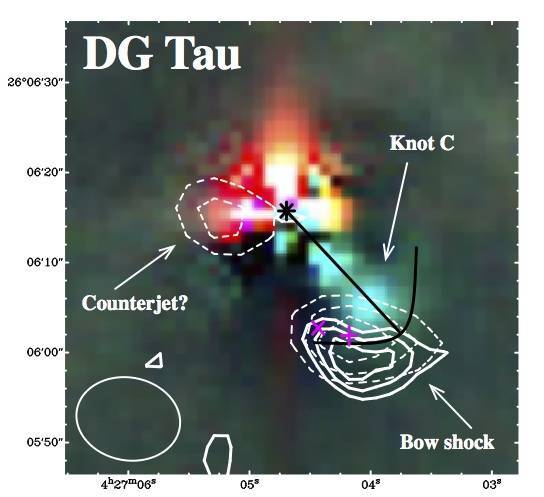Protostars: Forges of Cosmic Rays?
The study of the interaction of cosmic rays with the interstellar medium is a multidisciplinary task requiring the analysis of several physical and chemical processes. Being the primary source of ionisation in dense molecular clouds shielded by the interstellar ultraviolet radiation field, cosmic rays produce molecular ions and electrons that activate the rich chemistry of dense cold gas, leading to the formation of complex species. By determining the ionisation fraction, they fix the degree of coupling of the gas with the local magnetic field, thus controlling the dynamical evolution of molecular clouds and the efficiency of star and planet formation. In these processes, a fraction of the kinetic energy of cosmic-ray particles is converted into heating, so that cosmic rays also affect the thermal balance of molecular clouds determining their temperature. In addition, cosmic rays of energy of about 50-100 MeV produce light elements (Li, Be, B) by spallation reactions, while cosmic rays of energies in the range GeV-TeV contribute to the gamma-ray emission of molecular clouds via pion production and decay. Finally, in the inner part of a pre-stellar molecular core, cosmic rays control the distribution of charge of dust grains and therefore the rate at which grains coagulate to form bigger conglomerates, a fundamental mechanism for the formation of planetesimals.
The key parameter in the calculation of molecular abundances from observations and from chemical models as well as in non-ideal magnetohydrodynamic simulations is the cosmic-ray ionisation rate (ζ), that is the number of hydrogen molecules ionised per unit time.
While propagating from the interstellar medium up to the densest parts of molecular clouds, interstellar cosmic rays lose energy and their ionisation efficiency because of the presence of magnetic fields and collisions with molecular hydrogen. In recent years a wealth of observational data has shown that ζ can vary from 10–16 – 10–15 s–1 in diffuse clouds down to 10–18 – 10–17 s–1 in pre-stellar cores. Besides theoretical calculations indicate that ζ is even lower in a large central region of 100 to 200 AU, namely where the formation of a protostellar disc is expected.
However, recent observations hint at high levels of ionisation (ζ > 10–16 s–1) and at the presence of synchrotron emission in protostellar systems (see Fig. 1), which leads to an apparent contradiction, since these high values of ζ cannot be due to the interstellar cosmic-ray flux. Following the same reasoning, the interstellar cosmic-ray electron flux cannot explain the observed synchrotron emission.
A team of astronomers led by Marco Padovani of the Laboratoire Univers et Particules in Montpellier (France) and forthcoming astrofit fellow at the INAF-Osservatorio di Arcetri, investigated the possibility of accelerating particles, i.e. of generating local cosmic rays, inside or in the immediate vicinity of a protostar. In Padovani et al. (2015, 2016), they suggest a mechanism able to accelerate both cosmic-ray protons and electrons through diffusive shock acceleration, which can be used to explain the high ionisation rate and the synchrotron emission observed towards protostellar sources.
They analysed three main acceleration sites (shocks in accretion flows, along the jets, and on protostellar surfaces), finding that jet shocks can be strong accelerators of cosmic-ray protons, which can be boosted up to relativistic energies. Other promising acceleration sites are protostellar surfaces, where shocks caused by impacting material during the collapse phase are strong enough to accelerate cosmic-ray protons. In contrast, accretion flow shocks are too weak to efficiently accelerate cosmic rays. Finally, though cosmic-ray electrons are weakly accelerated, they can gain a strong boost to relativistic energies through re-acceleration in successive shocks.
The existence of an internal source of energetic particles can have a strong and unforeseen impact on the ionisation of the protostellar disc, on the star and planet formation processes, and on the formation of pre-biotic molecules. It is also important to note that the acceleration of cosmic rays inside protostars predicted by this modelling would cause a local increase of the electron fraction within about 5-10 AU from the protostar. As a consequence, magnetorotational instability could still operate and the extension of the so called “dead zone” could be modified together with the planetesimal formation efficiency.
______
Figure 1. GMRT observations of DG Tau at 325 MHz (dashed contours) and 610 MHz (solid contours) overlaid on a composite RGB image built from I, Hα and [SII] bands from the TLS Schmidt telescope. The synthesised beam is shown as an ellipse in the bottom left corner. The EVLA positions of the bow shock at 5.4 and 8.5 GHz are shown as a plus (+) and a cross (×), respectively. The optical stellar position corrected for proper motions is shown as an asterisk (*) and the optical jet axis and bow shock are shown as solid black lines. From Ainsworth et al. (2014).



